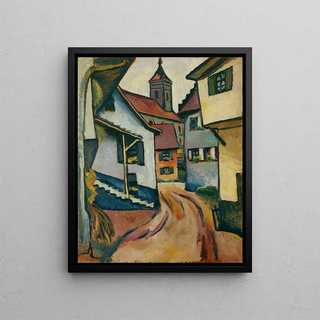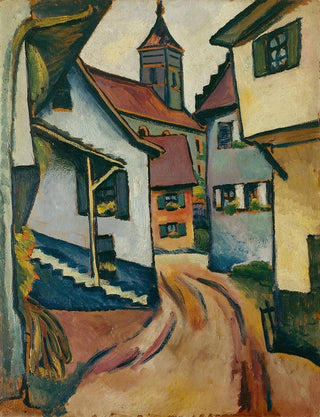Art print | Street with Church in Kandern - August Macke


View from behind

Frame (optional)
In the vibrant world of modern art, the art print "Rue avec église à Kandern" by August Macke stands out for its brilliance and its ability to capture the essence of a moment. Painted in 1911, this canvas evokes a snapshot of daily life, where architecture and nature meet in a colorful harmony. Macke, a prominent member of the expressionist group Der Blaue Reiter, offers through this composition a unique vision of his environment, blending reality with a personal interpretation filled with emotion. The light, colors, and shapes intertwine to create an almost dreamlike atmosphere, inviting the viewer to immerse themselves in a world where every detail tells a story.
Style and uniqueness of the work
"Rue avec église à Kandern" is characterized by its bold use of color and form. Macke, true to his style, opts for a luminous palette, where vivid shades of blue, yellow, and green intertwine with apparent ease. The church, majestic and serene, stands at the heart of the composition, while the surrounding houses, with gentle lines, seem to dance under a light breeze. The perspective chosen by the artist invites the eye to explore the depths of the canvas, creating a sense of movement and life. The work transcends the simple landscape to become a celebration of the beauty of the moment, where each element contributes to the visual symphony. This blend of abstraction and figuration reflects an era in full transformation, where art emancipates itself from conventions.
The artist and his influence
August Macke, born in 1887 in Meschede, is an emblematic figure of German expressionism. His artistic journey is marked by decisive encounters with other avant-garde artists, such as Wassily Kandinsky and Franz Marc. These exchanges nourish his innovative approach and his quest for a new aesthetic. Macke is interested in the psychology of color and its impact on human emotion, which is reflected in his works through bold compositions and thoughtful chromatic choices. His stay in Tun

Matte finish

View from behind

Frame (optional)
In the vibrant world of modern art, the art print "Rue avec église à Kandern" by August Macke stands out for its brilliance and its ability to capture the essence of a moment. Painted in 1911, this canvas evokes a snapshot of daily life, where architecture and nature meet in a colorful harmony. Macke, a prominent member of the expressionist group Der Blaue Reiter, offers through this composition a unique vision of his environment, blending reality with a personal interpretation filled with emotion. The light, colors, and shapes intertwine to create an almost dreamlike atmosphere, inviting the viewer to immerse themselves in a world where every detail tells a story.
Style and uniqueness of the work
"Rue avec église à Kandern" is characterized by its bold use of color and form. Macke, true to his style, opts for a luminous palette, where vivid shades of blue, yellow, and green intertwine with apparent ease. The church, majestic and serene, stands at the heart of the composition, while the surrounding houses, with gentle lines, seem to dance under a light breeze. The perspective chosen by the artist invites the eye to explore the depths of the canvas, creating a sense of movement and life. The work transcends the simple landscape to become a celebration of the beauty of the moment, where each element contributes to the visual symphony. This blend of abstraction and figuration reflects an era in full transformation, where art emancipates itself from conventions.
The artist and his influence
August Macke, born in 1887 in Meschede, is an emblematic figure of German expressionism. His artistic journey is marked by decisive encounters with other avant-garde artists, such as Wassily Kandinsky and Franz Marc. These exchanges nourish his innovative approach and his quest for a new aesthetic. Macke is interested in the psychology of color and its impact on human emotion, which is reflected in his works through bold compositions and thoughtful chromatic choices. His stay in Tun






